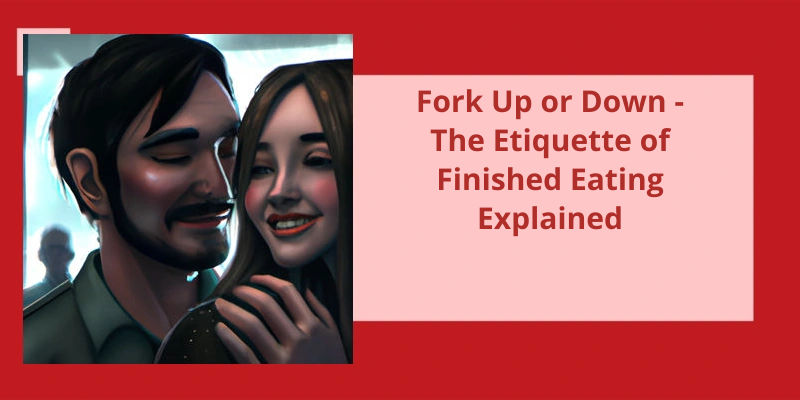The art of dining isn’t just about savoring the flavors and textures of your meal but also about observing proper etiquette. One of the most common concerns during a formal dining experience is how to signal that you’re done with your meal. To avoid any confusion or misinterpretation, it’s essential to know the proper way to place your utensils on your plate once you’re done eating. This may seem like a trivial matter, but it’s a sign of respect for your host or fellow diners, as well as a way to show that you’ve finished with your meal. Whether you prefer the American or European style, knowing the correct way to fork up or down when finished eating is a small but significant aspect of fine dining.
Do You Eat With a Fork Facing Down?
Eating with a fork facing down is a common practice for many people around the world. The decision to eat with the fork tines facing down is a personal preference and varies from person to person.
By holding the fork in this manner, they can easily spear their food and bring it to their mouth without having to readjust their hand or position. This can be particularly useful when eating foods that are difficult to cut or smaller pieces of food that require a delicate touch.
After cutting their food, some people prefer to rest their wrist at the edge of the table while holding their knife steady. This can help to provide additional support and stability while they eat. However, it’s important to note that this position may not be comfortable or practical for everyone and may vary depending on personal preference and physical ability.
When it comes to eating, it’s important to be mindful of proper etiquette and table manners. This includes holding your cutlery correctly and using them in a way that’s respectful and comfortable. While some may prefer to place their knife down between bites, others may find it more practical to hold it steady while eating.
No matter how you choose to hold your fork, the most important thing is to enjoy your meal and the company you’re with. By being mindful of proper table manners and etiquette, you can ensure that every dining experience is a pleasant and enjoyable one.
Mastering proper dining etiquette is essential for anyone who wants to make a good impression, especially in formal settings. When it comes to holding utensils, there are significant differences between the American and European styles. While the American style involves switching hands between the knife and fork, the European style keeps the knife in the right hand throughout the meal. Additionally, the orientation of the fork is different. In the European style, the fork is typically faced down with the tines curving up towards the mouth.
What Is the Difference Between American and European Fork Etiquette?
This difference in fork etiquette may seem small, but it reflects larger cultural variations between American and European dining practices. In the US, dining is often seen as a more casual affair, with an emphasis on speed and convenience. American dining etiquette allows for a more individualistic approach to eating, with each person using their utensils to cut and consume their own food at their own pace.
European dining, on the other hand, is often viewed as more formal and communal. Meals are seen as an opportunity to not only enjoy good food, but also to engage in conversation and socializing with others at the table. By allowing the knife to remain in the right hand, diners are able to cut and share dishes more easily, without interrupting the flow of conversation and interaction.
For example, in many European countries, it’s considered impolite to rest your elbows on the table or to speak with your mouth full. These rules reflect a broader emphasis on decorum and social graces in European society, which may explain why the more fluid style of fork etiquette has gained popularity in those regions.
Now that we know which way the fork tines should be pointing when eating Continental style, let’s take a deeper dive into the reasons why this etiquette practice exists and whether there are any exceptions to the rule.
Should You Eat With Fork Tines Up or Down?
This is because Continental style is all about efficient manners and ensuring that your table setting is tidy and organized. The tines down position is seen as a more courteous and refined way of dining, and it helps prevent any mess or drips from falling off the fork onto the table or your lap.
On the other hand, in American style, it’s acceptable to eat with the tines up or down, but the most common practice is to switch the tines upwards when cutting food with a knife. This allows the fork to hold the food more securely and makes it easier to cut through. However, once the food is cut, the fork should be returned to the tines down position before eating.
Some people might argue that the tines up position is more aesthetically pleasing, especially when the fork is placed on the plate. However, this is purely a matter of personal preference. It’s important to note that the proper dining etiquette varies depending on the culture and region.
Source: Eating utensil etiquette
In addition to being a well-mannered habit, putting down your utensils in between bites can have significant health benefits. By taking the time to savor each bite and chew slowly, you’ll not only enjoy your food more but also give your body time to properly digest it. In this article, we’ll take a closer look at the benefits of mindful eating and share some tips for incorporating this practice into your daily routine.
Why Should You Put Your Fork Down Between Bites?
When we eat quickly, we tend to swallow food without fully chewing it. This can lead to digestion problems and even cause us to overeat. By putting down your fork between bites, you give your body time to properly chew and prepare the food for digestion. This makes it easier for your stomach to break down the food, reducing the chance of indigestion and other digestive issues.
In addition to these physiological benefits, taking the time to slow down and be mindful of each bite can also enhance the overall eating experience. When we eat quickly, we often miss out on the subtle flavors and textures of our food. By taking the time to savor each bite, we can fully appreciate the taste and enjoy the experience of eating.
Putting down your fork or spoon in between bites is also a common practice in many cultures around the world. In Japan, for example, it’s customary to take small bites and put down your chopsticks between each bite. This tradition not only helps to regulate your appetite but also serves as a way of expressing gratitude and appreciation for the food.
Finally, putting down your utensils in between bites is simply good manners. It shows respect for the food and the dining experience, and it also makes for a more pleasant atmosphere at the table. When we eat with others, taking the time to slow down and be mindful of our eating can help to foster conversation and connection. Your body, your taste buds, and your dining companions will thank you!
Now that we know how to properly place our forks and knives on a plate, let’s talk about a specific type of fork – the pastry fork. This specially designed fork is perfect for indulging in desserts, with it’s uniquely shaped tines and beveled edges. But where exactly does it belong on the table setting? Read on to find out.
How Do You Put Forks on a Plate?
When it comes to setting a table for a meal, there are a few key rules to follow in terms of utensil placement. One of the most important is to remember to place forks to the left of the plate, with knives on the right and blade edges facing inwards towards the plate. This allows guests to easily access their utensils during the meal, providing a smooth and efficient dining experience.
In addition to placing forks and knives in their correct positions, it’s also important to consider the placement of soup spoons. These should be placed on the right of the knives, providing easy access for guests when soup is served. It’s important to make sure the soup spoon is clean and dry before placing it on the table, as any residue or dampness can detract from the dining experience.
When it comes to desserts, a pastry fork or cake fork can be used for consuming pastries and other sweet treats. These forks typically have three or four tines, and are designed to make it easy to pick up small, delicate items without ruining their shape or appearance. These should be placed on the table to the left of the dessert plate, ready for guests to use at the end of their meal.
Finally, it’s important to remember to place the dessert spoon above the plate, with the fork prongs facing right and the spoon bowl facing left. With these simple tips in mind, anyone can successfully set a table for a meal, creating a beautiful and enjoyable dining experience for all involved.
It’s no secret that portion control plays a significant role in maintaining a healthy diet and weight. However, the speed at which we consume our meals is just as important as the quantity. As it turns out, taking a break between bites can help your body better regulate appetite and prevent overeating. In fact, a recent study sheds some light on just how long you should wait between bites to see meaningful results.
How Long Should You Pause Between Bites?
The idea of waiting between bites has been talked about for years as a way to prevent overeating and promote healthy eating habits. The theory is that by taking the time to properly chew and savor each bite, your body has time to signal to your brain that it’s full, ultimately preventing you from overindulging. In recent years, the idea has gained more traction as studies have been conducted to investigate the benefits of pausing between bites.
One study from the University of California found that by waiting 30 seconds in between bites of food, children were less likely to overeat because their hunger signals had time to kick in. The study followed 54 preschoolers and found that those who were given a snack and asked to wait before eating the next bite consumed less food overall.
Another study published in the American Journal of Clinical Nutrition found similar results in adults. The study followed 35 adults and found that those who were asked to take a short pause between bites consumed 10% less food than those who ate without pausing.
But how long should you pause between bites? The answer may vary depending on the individual and the type of food being consumed. The key is to be mindful of your eating habits and take the time to tune into your bodys hunger signals.
Other factors, such as portion control, consuming a balanced diet, and staying hydrated are also important in maintaining a healthy weight and preventing overeating. Ultimately, the key is to be mindful of your eating habits and work towards developing a healthy relationship with food.
The Impact of Different Types of Foods on the Need for Pausing Between Bites
- Processed foods may lead to faster eating and less pausing between bites.
- Foods high in fiber and protein may increase fullness and lead to more pauses between bites.
- Eating slowly and taking pauses between bites can help with portion control and overall food intake.
- Intentionally choosing foods that require more chewing can lead to more pauses between bites and a greater sense of satisfaction.
- Mindful eating practices, such as paying attention to flavor and texture, can also increase the frequency of pausing between bites.
Conclusion
In conclusion, the way in which we signal the end of a meal by positioning our utensils is deeply ingrained in our cultural practices and etiquette. The proper placement of our fork and knife can convey a sense of respect and politeness towards our dining companions, as well as showcase our familiarity with societal norms. Whether it's the American-style with the fork tines facing up or the Continental-style with the fork tines facing down, the act of signaling the end of our meal through our utensil placement is a subtle yet effective way to show our appreciation for the experience we’ve just shared with those around us.






